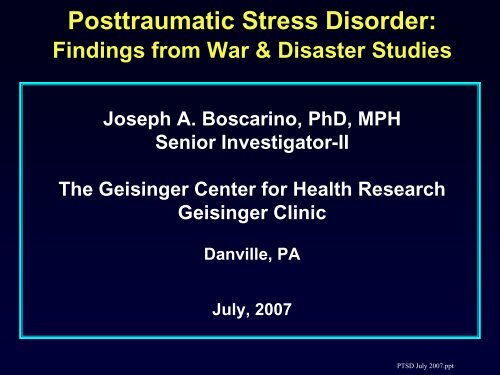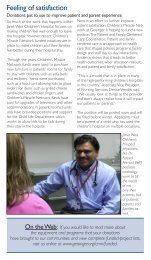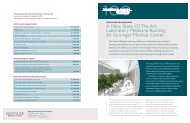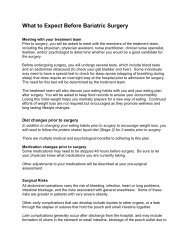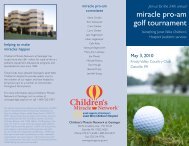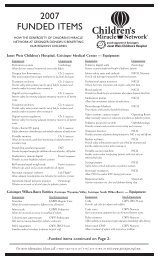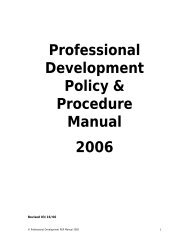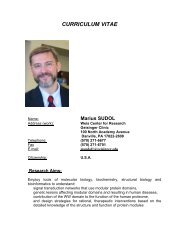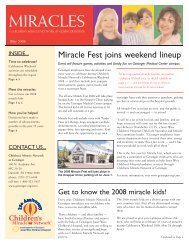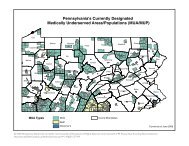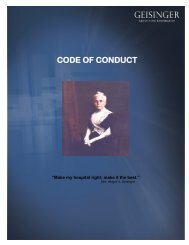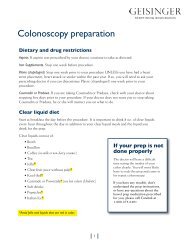Posttraumatic Stress Disorder: - Geisinger Health System
Posttraumatic Stress Disorder: - Geisinger Health System
Posttraumatic Stress Disorder: - Geisinger Health System
Create successful ePaper yourself
Turn your PDF publications into a flip-book with our unique Google optimized e-Paper software.
<strong>Posttraumatic</strong> <strong>Stress</strong> <strong>Disorder</strong>:<br />
Findings from War & Disaster Studies<br />
Joseph A. Boscarino, PhD, MPH<br />
Senior Investigator-II<br />
The <strong>Geisinger</strong> Center for <strong>Health</strong> Research<br />
<strong>Geisinger</strong> Clinic<br />
Danville, PA<br />
July, 2007<br />
PTSD July 2007.ppt
History of <strong>Posttraumatic</strong> <strong>Stress</strong> <strong>Disorder</strong><br />
(PTSD)<br />
• Symptoms recognized during Civil War<br />
• Shell shock in World War I<br />
• Combat fatigue in World War II<br />
• Combat neurosis in Korean War<br />
• Acute stress reaction in Vietnam War<br />
• PTSD post-Vietnam War in 1980s – DSM-III<br />
• PTSD expanded in 1990s – DSM-IV
Recognition of PTSD post-Vietnam War<br />
• Returning veterans present adjustment<br />
problems/psychopathology<br />
• Veteran advocates label “Vietnam Veteran<br />
Syndrome” (VVS)<br />
• Advocates lobby to have VVS in recognized<br />
• DSM-III committee of APA agreed but required<br />
compromise<br />
• Compromise was it would be called PTSD &<br />
also apply to rape/abuse victims and<br />
others; Incorporated in DSM-III in 1980
PTSD in US Civil War
PTSD Diagnosis in 1994 – DSM-IV<br />
• A1. Exposure to traumatic event (now broadly<br />
defined & subjective)<br />
• A2. Experienced fear, helplessness, horror<br />
• B. Re-experiences traumatic event<br />
• C. Avoid stimuli associated with event<br />
• D. Experiences hyper-arousal symptoms<br />
• E. Duration of symptoms > 1 month<br />
• F. Symptom cause distress or impairment
Prevalence of Traumatic Event Exposure<br />
• Lifetime experience of qualifying<br />
traumatic even in U.S.: 60-90% 1,2,3,4<br />
• Lifetime prevalence of crime/aggravated<br />
assault: 36% 2<br />
• Prevalence higher in recent surveys<br />
using DSM-IV criteria<br />
1. Norris, FH. 1992. J Conslt Clin Psychol, 60:409-418<br />
2. Resnick, H. 1993. J Consult Clin Psychol, 61:984-991<br />
3. Breslau, N. 1998. Arch Gen Psychiatry, 55:626-632<br />
4. Kessler, R. 1995. Arch Gen Psychiatry, 52:1048-1060
Prevalence of PTSD<br />
• General population prevalence of PTSD in<br />
U.S.: 7.8-9.2% 1,3<br />
• Women twice as likely as men to have lifetime<br />
PTSD 1<br />
• Conditional risk of PTSD after<br />
sexual/aggravated assault: 20-60% 1,2,3<br />
• Conditional risk of PTSD after community<br />
disaster: 3.7 for men and 5.4% for women 1<br />
1. Kessler, R. 1995. Arch Gen Psychiatry, 52:1048-1060<br />
2. Resnick, H. 1993. J Consult Clin Psychol, 61:984-991<br />
3. Breslau, N. 1998. Arch Gen Psychiatry, 55:626-632
PTSD <strong>Stress</strong>or Model<br />
Exposure<br />
Trauma Exposure<br />
Acute<br />
PTSD Sx Occur after Exposure<br />
Chronic<br />
Long-term Psychological Distress,<br />
PTSD, Co-morbid PTSD, etc.
PTSD and the Brain
PTSD – Potential<br />
biologic mechanisms affected<br />
<br />
Hypthalamic-pituitary-adrenal (HPA) system<br />
- e.g.,Cortisol down-regulation<br />
<br />
<br />
Sympathetic-adrenal-medullary (SAM) system<br />
- e.g., Catecholamine up-regulation<br />
Autonomic nervous (AN) system:<br />
- e.g., Hyper-reactivity/startle response increased<br />
These alterations may directly/indirectly increase<br />
“allostatic” load and may lead to disease in some<br />
individuals
Findings in 2006: PTSD and health<br />
<br />
<br />
Many Populations Studied:<br />
Disaster & Terrorism Victims, Veterans,<br />
Sexual & Physical Assault Victims, POWs,<br />
Refugees, Concentration Camp Survivors<br />
Many <strong>Health</strong> Outcomes Examined:<br />
Mental <strong>Health</strong> Status, Cardiovascular Disease,<br />
Diabetes, GI Disease, CFS, Musculoskeletal<br />
Disease, Neurological <strong>Disorder</strong>s, Chronic Pain,<br />
Somatic <strong>Disorder</strong>s, Lower Functional Status,<br />
Higher <strong>Health</strong>care Use, Mortality
PTSD Consequences among War-Fighters<br />
Joseph A. Boscarino, PhD, MPH<br />
Senior Investigator-II<br />
The <strong>Geisinger</strong> Center for <strong>Health</strong> Research<br />
Danville, PA<br />
PTSD_pres 2006.ppt
Veterans Study References<br />
J.A. Boscarino, S.N. Hoffman SN. Consistent association between mixed lateral preference and<br />
PTSD: Confirmation among a national study of 2,490 US Army Vietnam veterans. Psychosomatic<br />
Medicine 69: 2007, 365-369.<br />
J.A. Boscarino. PTSD and Mortality among US Army Veterans 30 Years after Military Service,<br />
Annals of Epidemiology, 16: 2006, 248-256.<br />
J.A. Boscarino. <strong>Posttraumatic</strong> <strong>Stress</strong> <strong>Disorder</strong> and Physical Illness: Results from<br />
Clinical & Epidemiologic Studies. Annals of NY Academy of Sciences 2004; 1030: 141-153.<br />
J.A. Boscarino, J. Chang. Higher Abnormal Leukocyte and Lymphocyte Counts 20 Years after<br />
Exposure to Severe <strong>Stress</strong>: Research and Clinical Implications. Psychosomatic Medicine 61: 1999,<br />
378-386.<br />
J.A. Boscarino, J. Chang. Electrocardiogram Abnormalities among Men with <strong>Stress</strong>-Related<br />
Psychiatric <strong>Disorder</strong>s: Implications for Coronary Heart Disease and Clinical Research. Annals of<br />
Behavioral Medicine 21: 1999, 227-234.<br />
J.A. Boscarino. Diseases among Men 20 Years after Exposure to Severe <strong>Stress</strong>: Implications for<br />
Clinical Research and Medical Care. Psychosomatic Medicine 59: 1997, 605-614.<br />
J.A. Boscarino. Post-Traumatic <strong>Stress</strong> <strong>Disorder</strong>, Exposure to Combat, and Lower Plasma Cortisol<br />
among Vietnam Veterans: Findings and Clinical Implications. Journal of Consulting and Clinical<br />
Psychology 64: 1996, 191-201.<br />
J.A. Boscarino. Post-Traumatic <strong>Stress</strong> & Associated <strong>Disorder</strong>s among Vietnam Veterans: The<br />
Significance of Combat Exposure and Social Support. Journal of Traumatic <strong>Stress</strong> 8: 1995, 317-36.
Vietnam Experience Study<br />
(diseases 17 Years Post-discharge; N = 2,490)<br />
48,513 Theater<br />
and Era Veterans<br />
1985-86<br />
From 4.9 Million<br />
1985-86<br />
7,924 Theater Vets<br />
Contacted for Phone<br />
Interview (CR=87%)<br />
7,364 Era Vets<br />
Contacted for Phone<br />
Interview (CR=84%)<br />
2,490 Theater Vets<br />
Underwent Examinations<br />
and Tests (CR=75%)<br />
1,972 Era Vets<br />
Underwent Examinations<br />
and Tests (CR=63%)<br />
CR=Completion Rate
Adjusted Plasma Cortisol Concentrations among<br />
Theater Veterans by Combat Exposure (p for trend
PTSD Biology
Logistic Regression Predicting Abnormal ECG for Veterans by<br />
Current PTSD, Complex PTSD & General Anxiety (N=2,490)<br />
PTSD Complex PTSD GAD<br />
ECG Classification OR OR OR<br />
Q-Wave Infarctions (n=30) 4.6** 2.6* 1.5<br />
Arrhythmias (n=209) 1.9 2.0** 1.5<br />
AV Conduction Def. (n=78) 2.9** 1.7 0.4<br />
Any Abnormal ECG (n=365) 2.0** 1.5* 1.6**<br />
(n=) (54) (124) (123)<br />
*p< 0.10 **p< 0.05<br />
Boscarino & Chang. Annals of Behavioral Medicine 21: 1999, 227-234.
Specific Autoimmune Diseases among<br />
Theater Veterans by Complex PTSD (N=2490)<br />
AD Type<br />
Adjusted*<br />
O.R. (O.R. 95% C.I.) p-value<br />
Rheum. Arthritis 5.2 (2.3-11.9)
Logistic Regression: PTSD and Mixed Handedness<br />
plus High Combat Exposure (N=2490)<br />
Adjusted*<br />
Mixed + High Combat O.R. (O.R. 95% C.I.) p-value<br />
Edinburgh +/- 70 2.5 (1.6-3.7)
PTSD Symptoms by Combat Exposure & Handedness
Clinical Profile of PTSD Cases (n=124)<br />
among Vietnam Veteran Cohort (N=2490)<br />
• T-lymphocytes counts above normal range (p
PTSD, Inflammation & Disease: Pathogenesis of RA
Trauma and <strong>Health</strong>: Cardiovascular Disease<br />
Vietnam Veterans: Population Study (Boscarino & Chang, 1999)<br />
- Increase abnormal 12-lead ECGs (e.g., Q-wave infarcts)<br />
WW II & Korean Vets: Population Study (Schnurr et al. (2000)<br />
- Increase in physician-diagnosed arterial disease<br />
• Dutch Resistance Vets: Population Study (Falger et al. 1992)<br />
- Increase in reported angina pectoris<br />
• Ex-POWs: Clinical Study (Corovic et al. 2000)<br />
- Increase in abnormal 12-lead ECGs (e.g., Q-wave infarcts)<br />
• Beirut Civil War Civilians: Clinical Study (Sibai et al. 1989)<br />
- Increase in arteriographic coronary artery disease<br />
Chernobyl Disaster: Population Study (Cwikel et al. 1997)<br />
- Increase in reported heart disease<br />
Childhood Trauma: Population Study (Felitti et al., 1998)<br />
- Increase in adult ischemic heart disease based on exam<br />
• Sexual Assault History: Population Study (Golding 1994)<br />
- Increase in cardiovascular disease symptoms
Vietnam Experience Study<br />
(Deaths 30 Years Post-discharge; N = 15,288)<br />
1985-86<br />
2000<br />
7,924 Theater Vets<br />
Contacted for Phone<br />
Interview (CR=87%)<br />
7,924 Theater Vets<br />
Vital Status Determined<br />
(CR > 95%)<br />
48,513 Theater<br />
and Era Veterans<br />
From 4.9 Million<br />
7,364 Era Vets<br />
Contacted for Phone<br />
Interview (CR=84%)<br />
7,364 Era Vets<br />
Vital Status Determined<br />
(CR > 95%)<br />
1985-86<br />
2000<br />
CR=Completion Rate
Profile of Vietnam Theater vs. Era Veterans<br />
(N=15,288)<br />
Variables Theater Era P-value*<br />
PTSD at interview 10.6 2.9
Profile of PTSD Positive vs. PTSD Negative Veterans<br />
(N=15,288)<br />
Variables Negative Positive P-value<br />
Dead at 2000 at follow-up 4.9 11.8
Cox Regression: Mortality among all Veterans<br />
by PTSD Status (Person-years at risk =229,565)<br />
(N=15,288)<br />
Cause of Death<br />
Adjusted*<br />
H.R. (H.R. 95% C.I.) p-value<br />
All cause (n=820) 2.1 (1.7-2.6)
Cox Regression: Mortality among Era Veterans<br />
by PTSD Status (Person-years at risk = 110,553)<br />
(N=7,364)<br />
Cause of Death<br />
Adjusted*<br />
H.R. (H.R. 95% C.I.) p-value<br />
All cause 2.0 (1.3-3.0) 0.001<br />
CVD 1.2 (0.4-3.4) 0.69<br />
Cancer 0.9 (0.3-3.1) 0.92<br />
External** 2.2 (0.9-5.2) 0.073<br />
*Adjusted for race, age, IQ, military history, smoking history.<br />
** External cause = homicide, suicide, drug overdose,<br />
accidents of undermined intent, etc.<br />
Boscarino. Annals of Epidemiology, 16: 2006, 248-256.
Cox Regression: Mortality among Theater Veterans<br />
by PTSD Status (Person-years at risk = 119,453)<br />
(N=7,364)<br />
Cause of Death<br />
Adjusted*<br />
H.R. (H.R. 95% C.I.) p-value<br />
All cause 2.2 (1.7-2.7)
Veteran study conclusions<br />
• Veterans with current PTSD had for years - since acquired<br />
(mostly) from Vietnam combat - hence, could be causative<br />
for in disease<br />
• Vets were “disease free” at service induction and disease<br />
onset was post service, thus causal ordering correct<br />
• Current lymphocyte, cortisol, hormonal & DTH findings<br />
support the presence of “inflammatory” diseases among<br />
the veterans<br />
• Given above & the controls for bias & confounding, is<br />
plausible PTSD-related stress may cause disease among<br />
veterans<br />
• PTSD-behavioral psychopathogenesis is likely an<br />
additional factor for disease burden & cause of death
World Trade Center Disaster Study
Study Contributors<br />
• Joseph Boscarino, PhD, MPH – Study Director<br />
• Richard Adams, PhD<br />
• Charles Figley, PhD<br />
• Sandro Galea, MD, DrPH<br />
• Heidi Resnick, PhD<br />
• Edna Foa, PhD<br />
• Joel Gold, MD<br />
• Michael Bucuvalas, PhD<br />
• David Vlahov, PhD
WTCD Study References<br />
J.A. Boscarino, RE Adams, CR Figley, S Galea, EB Foa. Fear of Terrorism and Preparedness in New York<br />
City 2 Years after the Attacks: Implications for Disaster Planning and Research. J Pubic <strong>Health</strong> Manag. &<br />
Practice. 12: 2006, 501-509.<br />
J.A. Boscarino, R.E. Adams, C.R. Figley. Worker Productivity and Outpatient Service Use after the September<br />
11 th Attacks. American Journal of Industrial Medicine 49: 2006.<br />
R.E Adams, J.A. Boscarino. Predictors of PTSD and Delayed-PTSD after Disaster: The Impact of Exposure<br />
and Psychological Resources. Journal of Nervous and Mental Disease 194: 2006 485-493.<br />
J.A. Boscarino, R.E. Adams, E. Foa, P. Landrigan. A Propensity Score Analysis of Brief Worksite Crisis<br />
Interventions after the World Trade Center Disaster. Medical Care 44: 2006, 454-462.<br />
J.A. Boscarino, R.E. Adams, S. Galea. Alcohol use in New York after the Terrorist Attacks: A Study of the<br />
Effects of Psychological Trauma on Drinking Behavior. Addictive Behaviors 31: 2006, 606-621.<br />
R.E. Adams, J.A. Boscarino, S. Galea. Social and Psychological Resources and <strong>Health</strong> Outcomes after a<br />
Community Disaster. Social Science and Medicine 60: 2006, 176-188.<br />
J.A. Boscarino, RE Adams. Disparities in Mental <strong>Health</strong> Treatment following the World Trade Center Disaster:<br />
Implication for Mental <strong>Health</strong> Care and Services Research. J Traumatic <strong>Stress</strong> 18: 2005, 287-97.<br />
R.E. Adams, J.A. Boscarino. Differences in Mental <strong>Health</strong> Outcomes among Whites, African Americans, and<br />
Hispanics Following a Community Disaster. Psychiatry 68: 2005, 250-265.<br />
R.E. Adams, JA. Boscarino. <strong>Stress</strong> and Well-being in the Aftermath of the World Trade Center Attack: The<br />
Continuing Effects of Community-wide Disaster. Journal of Community Psychology 32: 2005, 175-190.
WTCD Study References<br />
J.A. Boscarino, R.E. Adams, C.R. Figley. Mental <strong>Health</strong> Service Use 1-Year after the World Trade<br />
Center Disaster: Implications for Medical Care. General Hospital Psychiatry 26: 2004, 346-358.<br />
D. Vlahov, S. Galea, H. Resnick, J. Ahern, J.A. Boscarino, M. Bucuvalas, J. Gold, D. Kilpatrick.<br />
Increased use of Cigarettes, Alcohol, and Marijuana among Manhattan residents after the<br />
September 11 th Terrorists Attacks. American Journal of Epidemiology 155: 2002, 988-996.<br />
J.A. Boscarino, C.R. Figley, R.E. Adams, S. Galea, H. Resnick, A.R. Fleischman, M. Bucuvalas, J.<br />
Gold. Adverse Reactions of Study Persons recently Exposed to Mass Urban Disaster. Journal<br />
of Nervous and Mental Disease 192: 2004, 515-524.<br />
J.A. Boscarino, S. Galea, R.E. Adams, J. Ahern, H. Resnick, D. Vlahov. Mental <strong>Health</strong> Service and<br />
Psychiatric Medication Use in New York City after the September 11, 2001, Terrorist Attack.<br />
Psychiatric Services 55: 2004, 274-283.<br />
J.A. Boscarino, C.R. Figley, R.E. Adams. Fear of Terrorism in NY after the September 11 Attacks:<br />
Implications for Emergency Mental <strong>Health</strong> and Preparedness. International Journal of<br />
Emergency Mental <strong>Health</strong> 5: 2003, 199-209.<br />
J.A. Boscarino, S. Galea, J. Ahern, H. Resnick, D. Vlahov. Psychiatric Medication Use among<br />
Manhattan Residents following the World Trade Center Disaster. Journal of Traumatic <strong>Stress</strong><br />
16: 2003, 301-306.
Previous studies of<br />
persons after disasters<br />
• Most research focused on persons directly<br />
affected<br />
• Few studies examined outcomes in a<br />
large-scale population study<br />
• Major Research Question in Our Study:<br />
Were post-disaster interventions<br />
beneficial?
Study design<br />
• Wave 1 Random-digit-dial phone surveys 1-year<br />
after (N=2,368) –> adults only<br />
• Over-sample of persons who had treatment after<br />
WTC disaster (~ 80%)<br />
• 45-minute mental health/trauma survey used<br />
• Wave 2 phone survey 1-year after W1 (2 years<br />
post-disaster)<br />
• Re-interviewed 71% of W1 respondents in W2<br />
• Wave 1 + Wave 2 longitudinal data = 1,681<br />
persons
Study sampling frame – 5 NYC boroughs<br />
sampled probability proportionate to size<br />
(N = 2,368)
Study measures<br />
• Main Dx and service measures from<br />
National Co-morbidity Study*<br />
• Intervention exposure assessed<br />
‣Determined if respondent attended intervention<br />
after WTC disaster<br />
‣Where sessions were conducted<br />
‣Number of sessions attended<br />
‣Clinical focus of sessions<br />
‣Perceptions of how helpful sessions were<br />
*RC Kessler, et al. The Epidemiology of Major Depression. JAMA 2003;<br />
289: 3095-3105.
Study outcomes measures<br />
• Outcomes assessed:<br />
‣ PTSD past year (DSM-IV)<br />
‣ Depression past year (DSM-IV)<br />
‣ Binge Drinking past year (6+ drinks)<br />
‣ Alcohol Dependency past year (CAGE)<br />
‣ SF-12 functional status<br />
‣ BSI-18: Somatization, Global Severity Index<br />
‣ Worker Productivity<br />
‣ Outpatient mental & health services use<br />
‣ Non-traditional services use.
Sample characteristics of w1 & w2<br />
compared to 2000 U.S. Census for NYC<br />
Characteristics US Census % Weighted W1<br />
Sample %<br />
Age<br />
18-24<br />
13.2<br />
15.2<br />
25-34<br />
22.5<br />
24.0<br />
35-44<br />
20.8<br />
22.2<br />
45-54<br />
16.7<br />
18.7<br />
55-64<br />
11.3<br />
10.0<br />
65+<br />
15.5<br />
9.8<br />
Weighted W2<br />
Sample %<br />
12.7<br />
21.3<br />
22.1<br />
20.3<br />
12.0<br />
11.7<br />
Race<br />
White<br />
African American<br />
Asian<br />
Hispanic<br />
Other<br />
38.7<br />
23.0<br />
10.1<br />
24.7<br />
3.6<br />
39.2<br />
26.3<br />
5.2<br />
25.7<br />
3.5<br />
43.0<br />
26.0<br />
4.6<br />
24.1<br />
2.4
Prevalence of PTSD and Depression in NYC<br />
4 and 12 months after September 11<br />
PTSD/Depression 4 Months (Sx) 12 Months (Dx)<br />
PTSD Ever 15.3 8.2<br />
PTSD Since 9/11 9.1 5.3<br />
PTSD Past 6 months -- 3.4<br />
Depression Since 9/11 7.8 8.2<br />
Peri-Event Panic Attack 16.7 10.8
Mental health service use 1-year before vs.<br />
1-year after disaster in NYC (N=2,368)<br />
Percent<br />
20<br />
15<br />
10<br />
5<br />
Pre-Disaster<br />
Post-Disaster<br />
0<br />
Pysch.<br />
Psychiat.<br />
Other MD<br />
MH Counsel.<br />
Soc. Wrk.<br />
Minister<br />
Self-Help<br />
Boscarino, et al. General Hospital Psychiatry 26: 2004, 346-358.<br />
Any Visits
WTC disaster event exposure<br />
assessment<br />
Rescue Effort<br />
Saw Inperson<br />
Fear of Injury/Death<br />
Relative/Friend Killed<br />
Lost Possessions<br />
Lost Job<br />
8.3%<br />
7.8%<br />
3.2%<br />
33.4%<br />
35.6%<br />
40.7%<br />
JA Boscarino et al. Mental <strong>Health</strong> Service Use 1-Year after the World Trade Center<br />
Disaster: Implications for Medical Care. General Hospital Psychiatry 26: 2004, 346-358.
Exposure to WTC disaster and<br />
mental health visits/medication use – W1<br />
(all comparisons significant at p
Prevalence of PTSD and depression by<br />
Exposure to WTC disaster - wave 1 (N=2,368)<br />
Percent<br />
20<br />
15<br />
10<br />
5<br />
0<br />
PTDS Past Year<br />
4.9<br />
3.8<br />
Low<br />
Exposure<br />
6.6<br />
4.3<br />
Moderate<br />
Exposure<br />
Depression Past Year<br />
10.9<br />
6.0<br />
High<br />
Exposure<br />
18.4<br />
12.6<br />
(both p
% Increased Drinking by Exposure<br />
to WTC Disaster Events<br />
Increase 2+ Drinks/Day<br />
Increase 2+ Days Drinking<br />
25<br />
20<br />
Increased drinks/day p0.05<br />
15<br />
10<br />
5<br />
0<br />
Low<br />
Exposure<br />
Moderate<br />
Exposure<br />
High<br />
Exposure<br />
Very High<br />
Exposure<br />
Boscarino et al. Alcohol use in NY after the terrorist attack. Addictive Behaviors 2006;31:606-621.
Differences in receiving crisis<br />
interventions at work by demographics<br />
Characteristic<br />
Gender<br />
Male<br />
Female<br />
Race<br />
White<br />
African American<br />
Hispanic<br />
Other<br />
(N=180)<br />
Received<br />
Intervention<br />
(p = ns)<br />
37.7<br />
62.3<br />
(p = ns)<br />
45.7<br />
20.1<br />
27.0<br />
7.2<br />
Boscarino, et al. Medical Care, 2006;44:454-462.<br />
(N=1,501)<br />
No<br />
Intervention<br />
46.8<br />
53.2<br />
42.7<br />
26.4<br />
23.9<br />
7.0
Percent<br />
% Received crisis intervention at<br />
work by exposure to WTC disaster<br />
25<br />
20<br />
15<br />
10<br />
5<br />
0<br />
10% NYC adults had postdisaster<br />
crisis interventions<br />
- 7% had at worksite<br />
1.5<br />
Low<br />
Exposure<br />
Received Intervention<br />
5.4<br />
Moderate<br />
Exposure<br />
11.6<br />
High<br />
Exposure<br />
(p
Number of crisis sessions<br />
received at work – wave 1 (n=180)<br />
17%<br />
44%<br />
One<br />
Two to<br />
Three<br />
Four or<br />
More<br />
39%<br />
Boscarino, et al.<br />
Medical Care 2006;44:454-462.
Log-odds ratio showing positive effect<br />
of counseling at follow-up – covariate adjusted<br />
0.5<br />
Log odds ratios<br />
0<br />
-0.5<br />
-1<br />
-1.5<br />
-2<br />
-2.5<br />
Binge<br />
Alc Dep<br />
Partial PTSD<br />
Depression<br />
Somatization<br />
Anxiety<br />
Global Impair<br />
One<br />
2 to 3<br />
No sessions = reference category<br />
Boscarino, et al. Medical Care 2006;44:454-462.
Delayed PTSD post-WTCD and Percent experiencing 2+<br />
stressful life events in past 2 years<br />
80%<br />
78% 79%<br />
70%<br />
60%<br />
50%<br />
40%<br />
44%<br />
54%<br />
39%<br />
58%<br />
Year 1<br />
Year 2<br />
30%<br />
20%<br />
14%<br />
18%<br />
10%<br />
Resilient<br />
n=1494<br />
Remitters<br />
n=92<br />
Delayed<br />
n=66<br />
Acute<br />
n=28<br />
Adams, Boscarino. Predictors of PTSD & delayed-PTSD after disaster. J Nervous and Mental Disease 2006;194:485-93.`
Delayed PTSD post-WTCD and percent experiencing<br />
Low self-esteem in past 2 years<br />
90%<br />
80%<br />
70%<br />
64%<br />
71%<br />
78%<br />
71%<br />
60%<br />
50%<br />
40%<br />
30%<br />
35%<br />
30%<br />
47%<br />
54%<br />
Year 1<br />
Year 2<br />
20%<br />
10%<br />
Resilient<br />
Remitters<br />
Delayed<br />
Acute<br />
n=1495<br />
n=92<br />
n=66<br />
n=28<br />
Adams, Boscarino. Predictors of PTSD & delayed-PTSD after disaster. J Nervous and Mental Disease 2006;194:485-93.
PTSD and Genetics
Search for Genetics of PTSD
Genetic basis of PTSD<br />
• One-third of PTSD variation due to genetics:<br />
• Serotonin transporter gene (SCL6A4)<br />
• Dopamine transporter & D 2 D 4 receptor genes<br />
• Monamine Oxidase A (MAOA) gene<br />
• Norepinephrine gene<br />
• Neuropeptide Y & Substance P genes<br />
• Neurobiologic factors associated w/ PTSD:<br />
• Mixed lateral handedness<br />
• Lower Intelligence<br />
• ADHD<br />
• NSS
Results of allelic variations for serotonin<br />
transporter gene (SLC6A4) x environmental exposure<br />
(A. Caspi, et al. Science 2003; 301: 386-391)
Current status of PTSD research<br />
• Search for PTSD genes underway<br />
• Advances in PTSD measures being made<br />
• Psychobiology of PTSD emerging<br />
• Impact of PTSD involves other major<br />
psychopathology<br />
• Studies of effectiveness of brief treatments<br />
• Treat PTSD early & prevent disease/death?
Multifactoral PTSD Outcome Model:<br />
Potential Causal Pathways to Disease Outcomes<br />
Heredity & Shared<br />
Environment<br />
Implications<br />
• Multi-level Analyses<br />
• Longitudinal Framework<br />
• Biologic Factors<br />
• Behavioral Analyses<br />
Psych Trauma<br />
Exposure<br />
<strong>Health</strong> Status<br />
Behavior<br />
Biological<br />
Alterations<br />
PTSD


